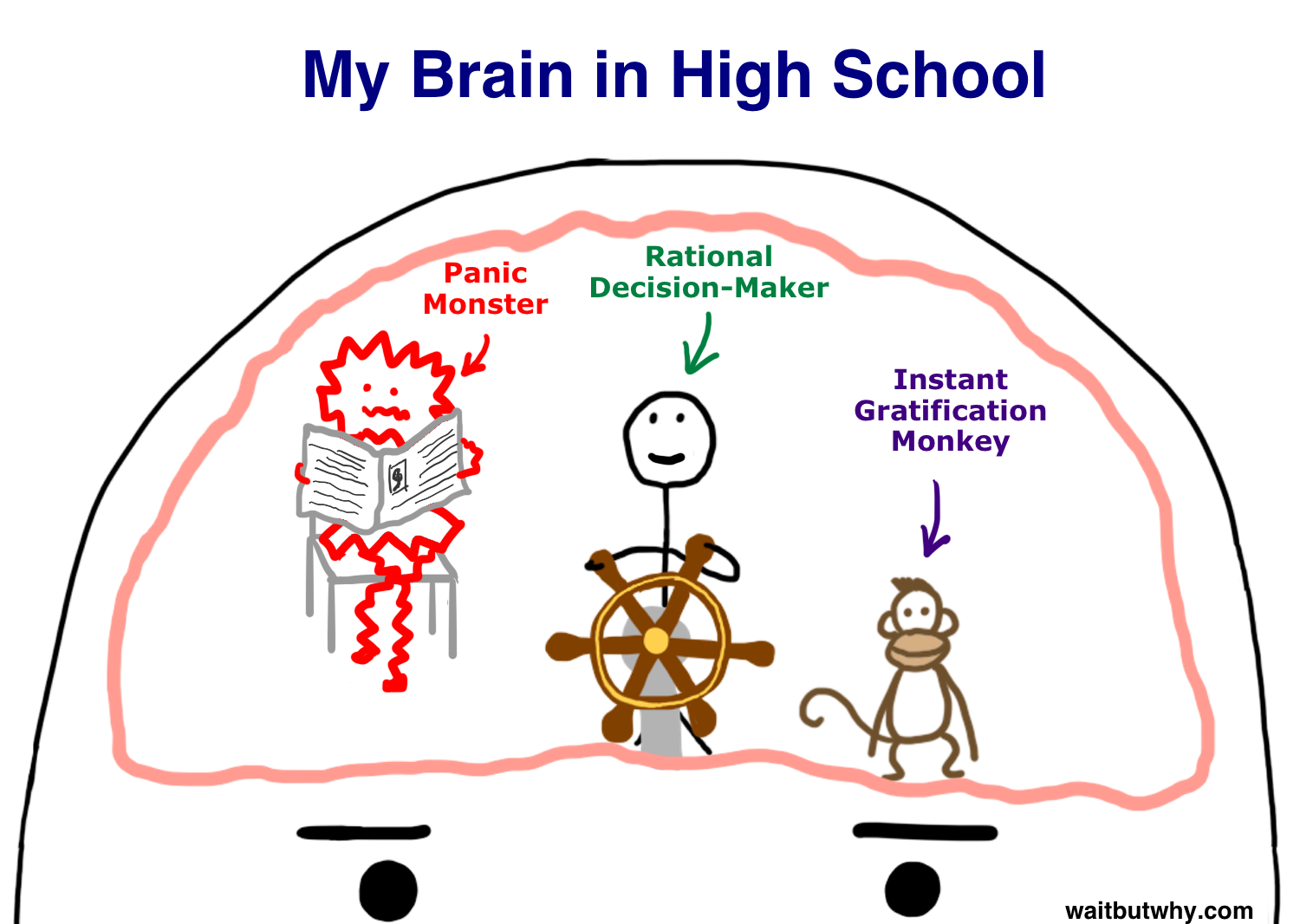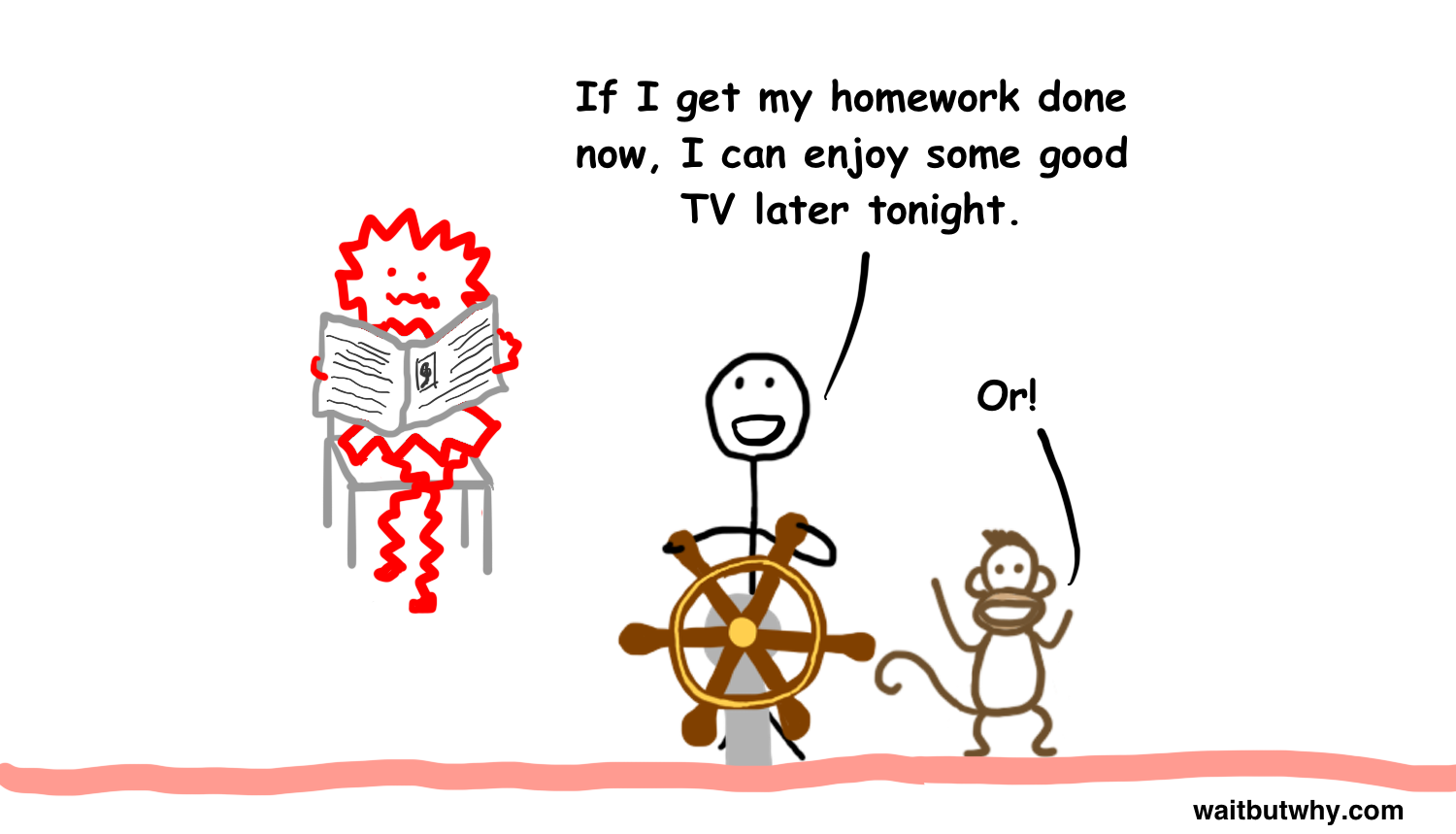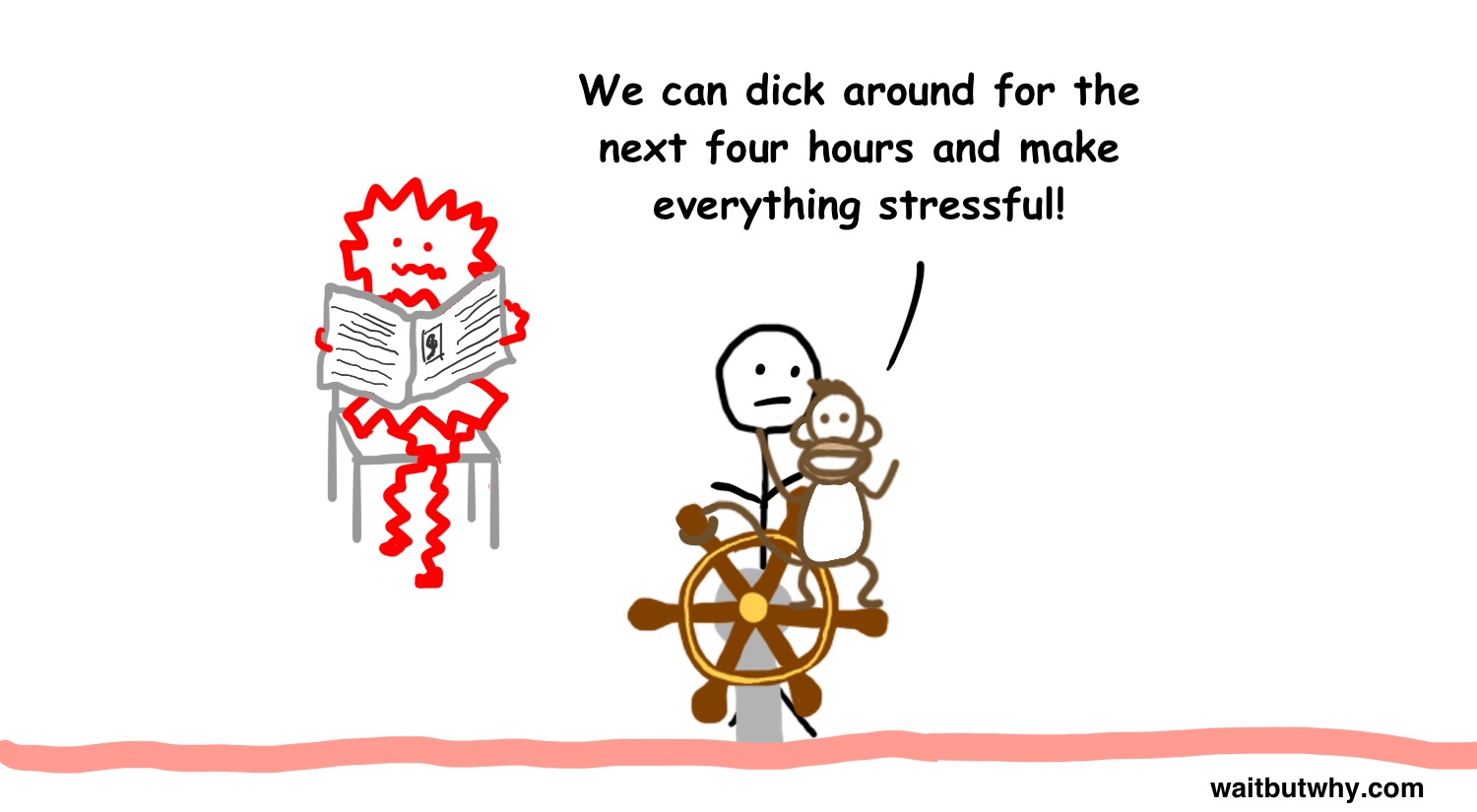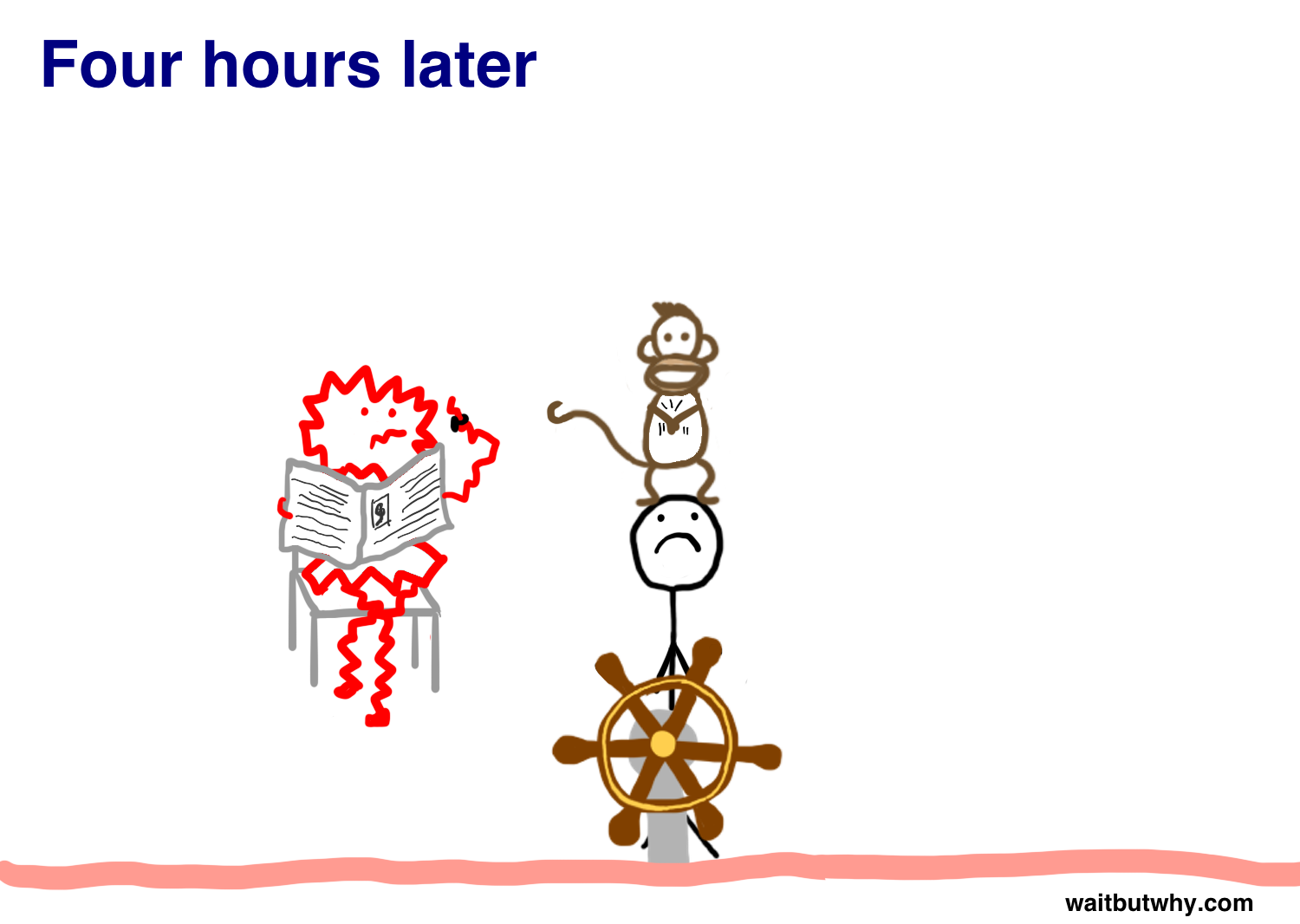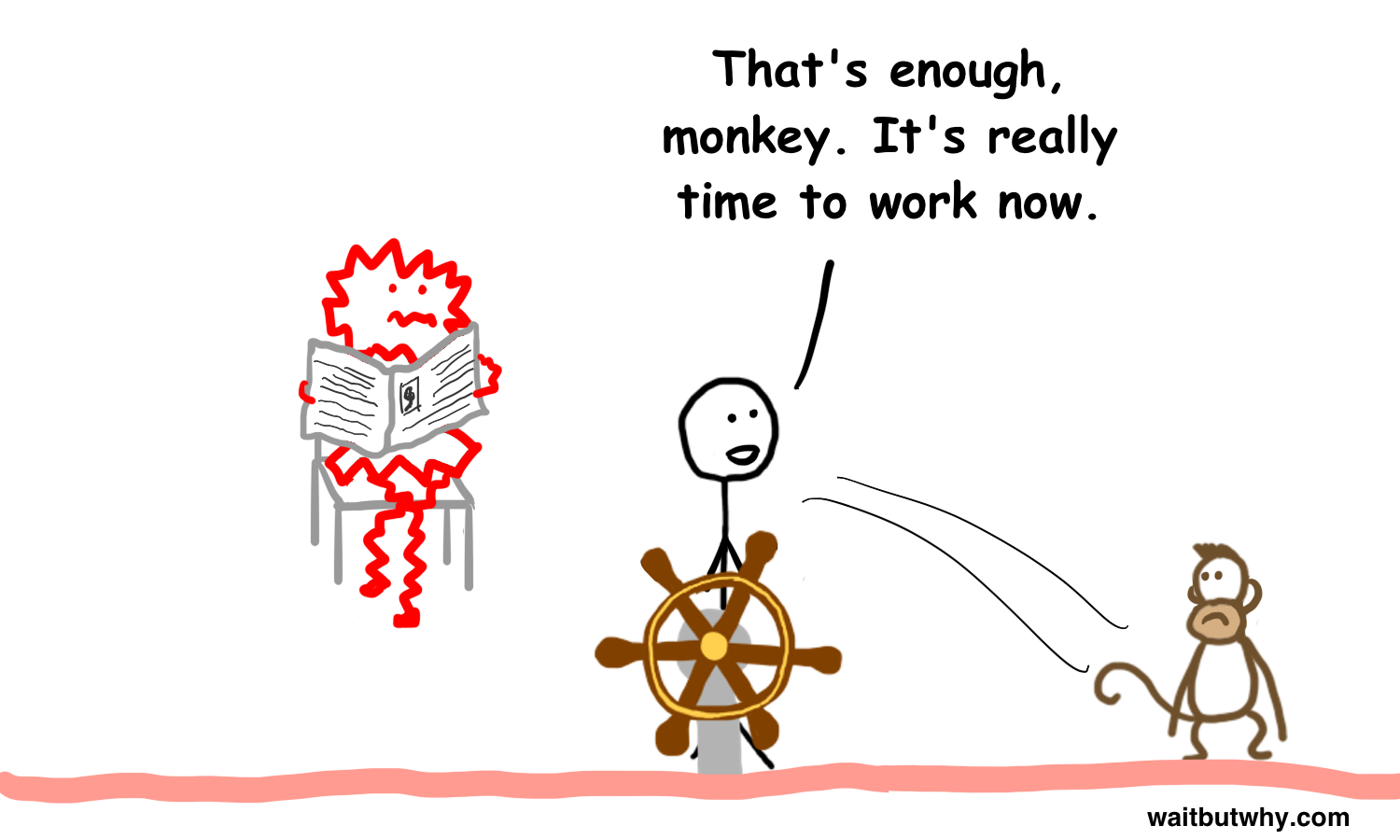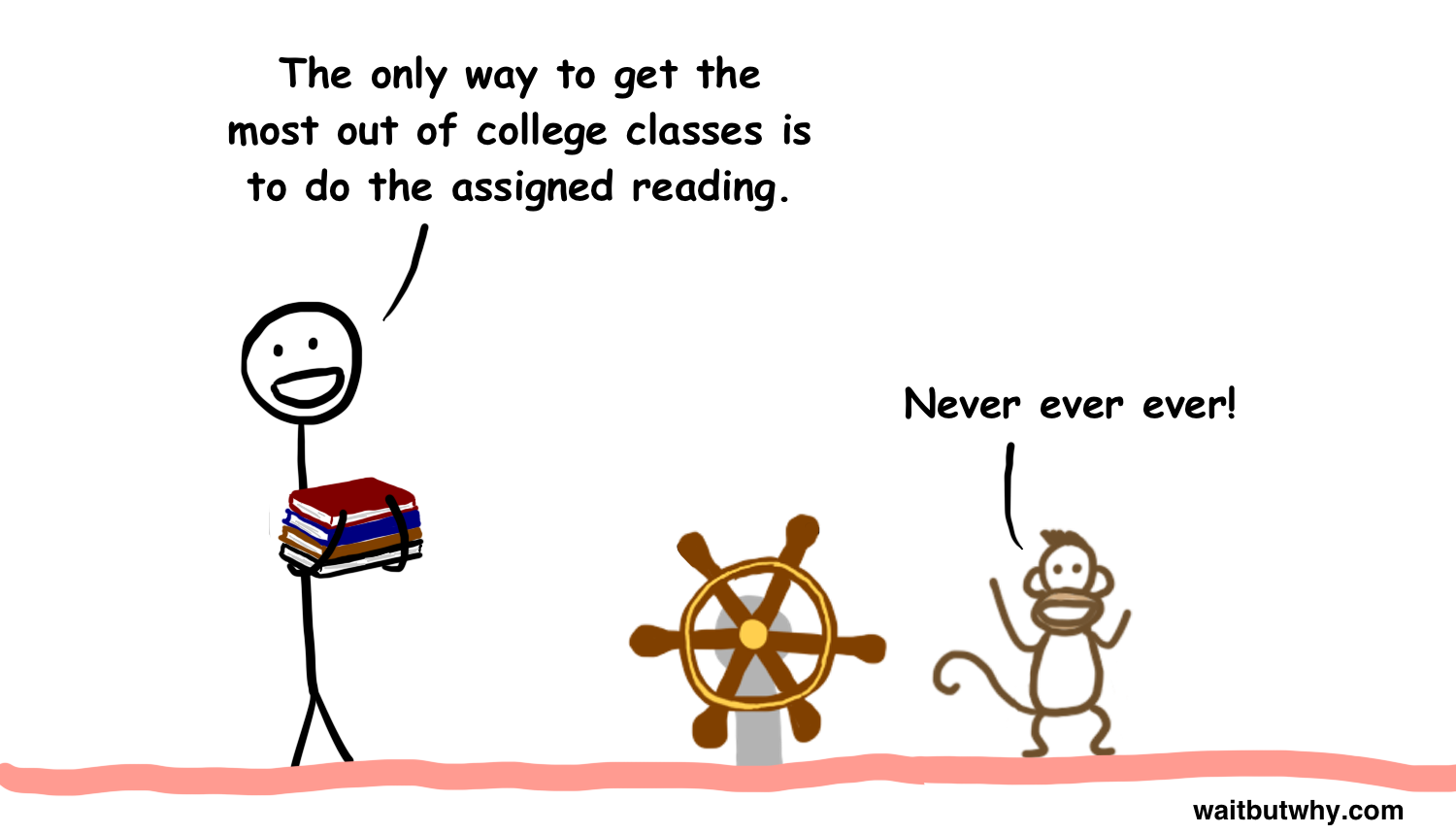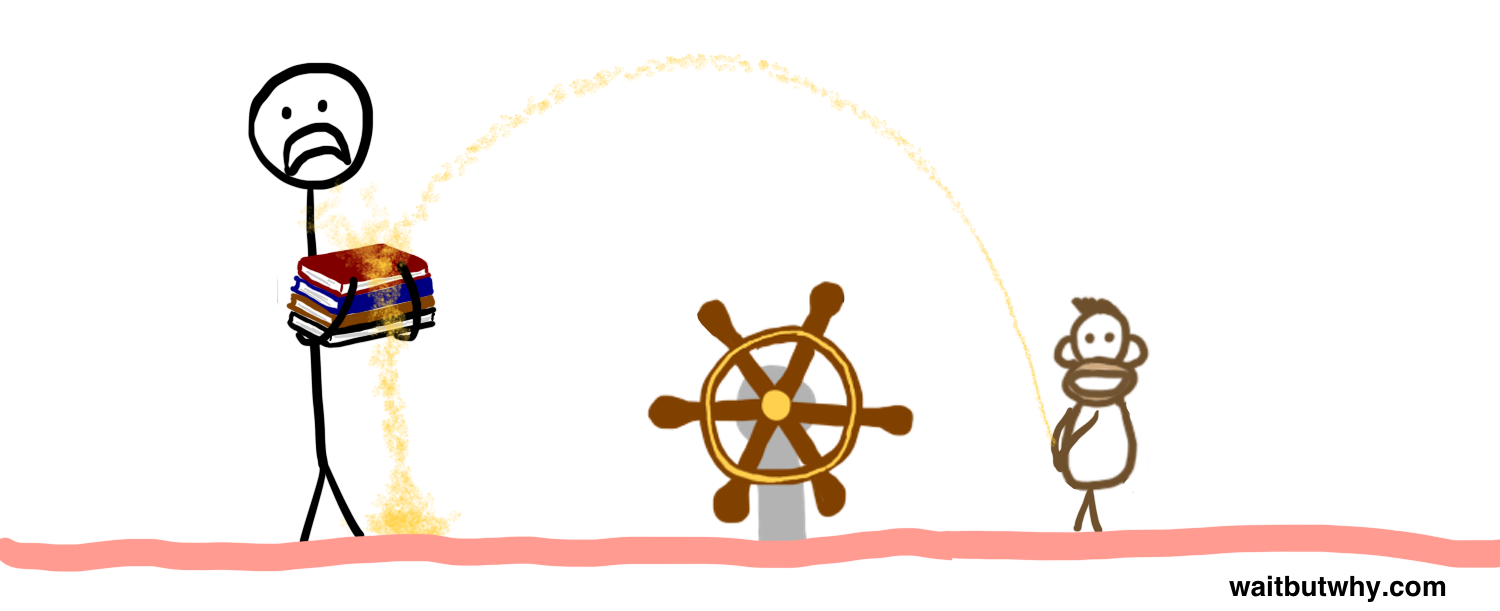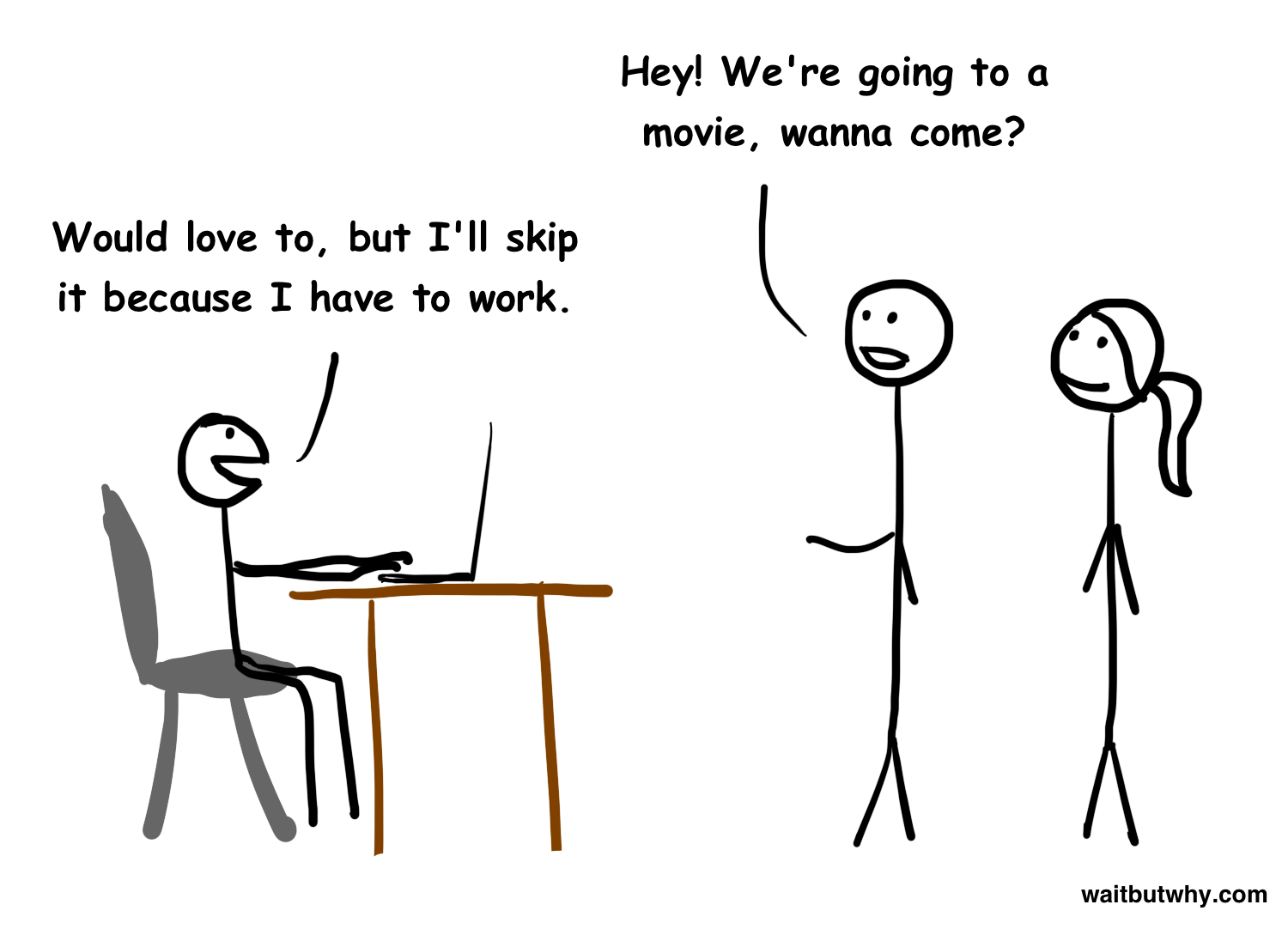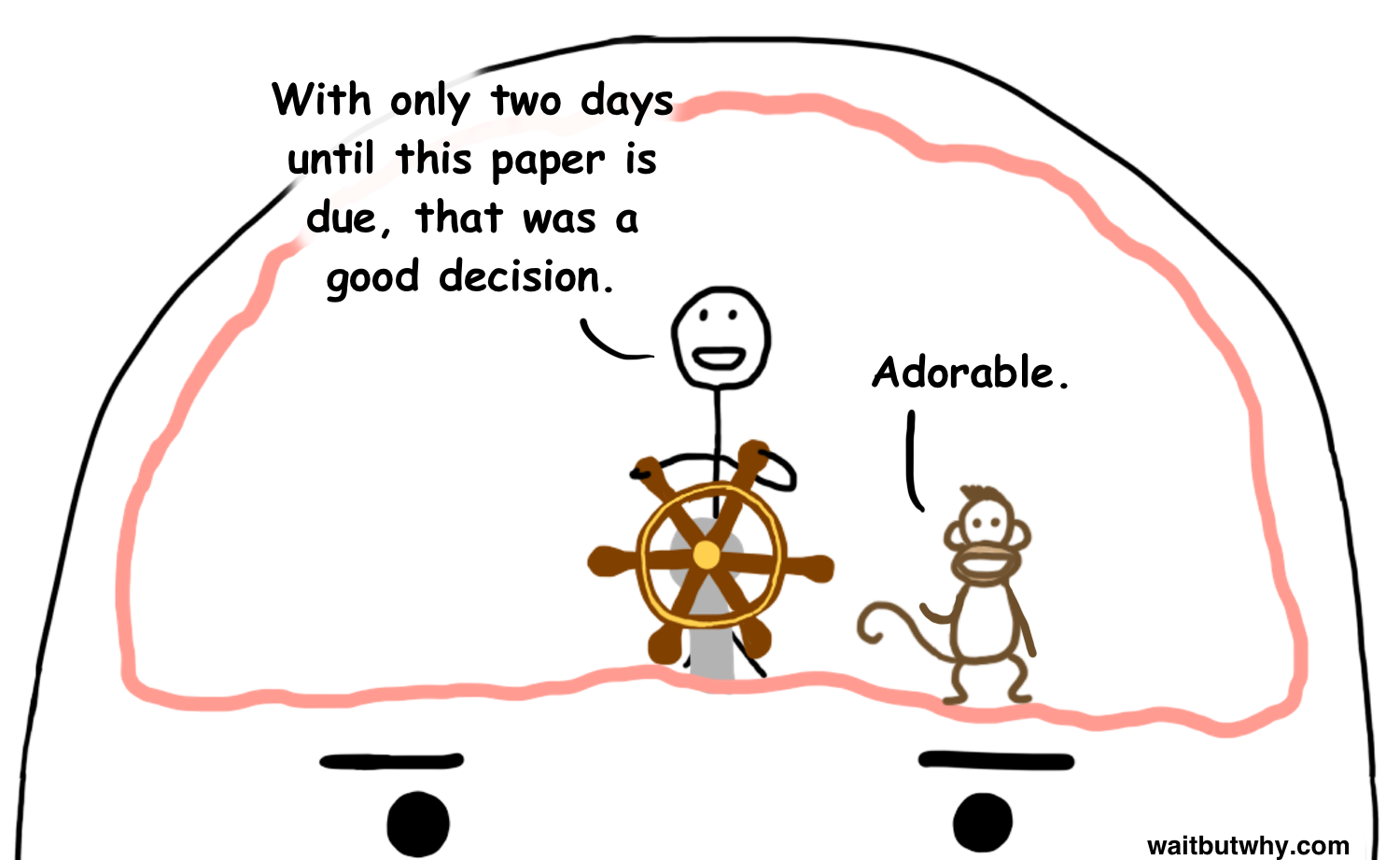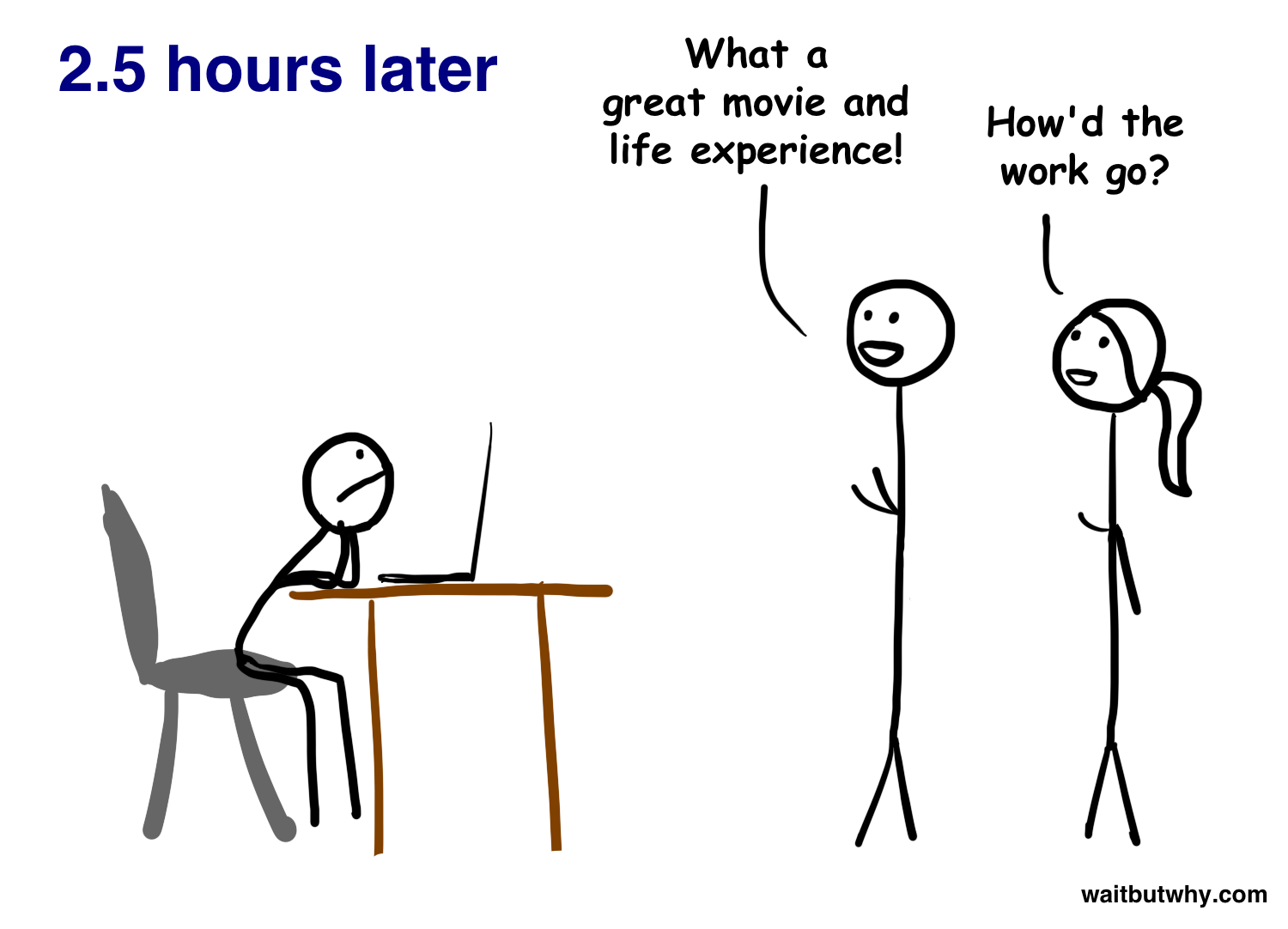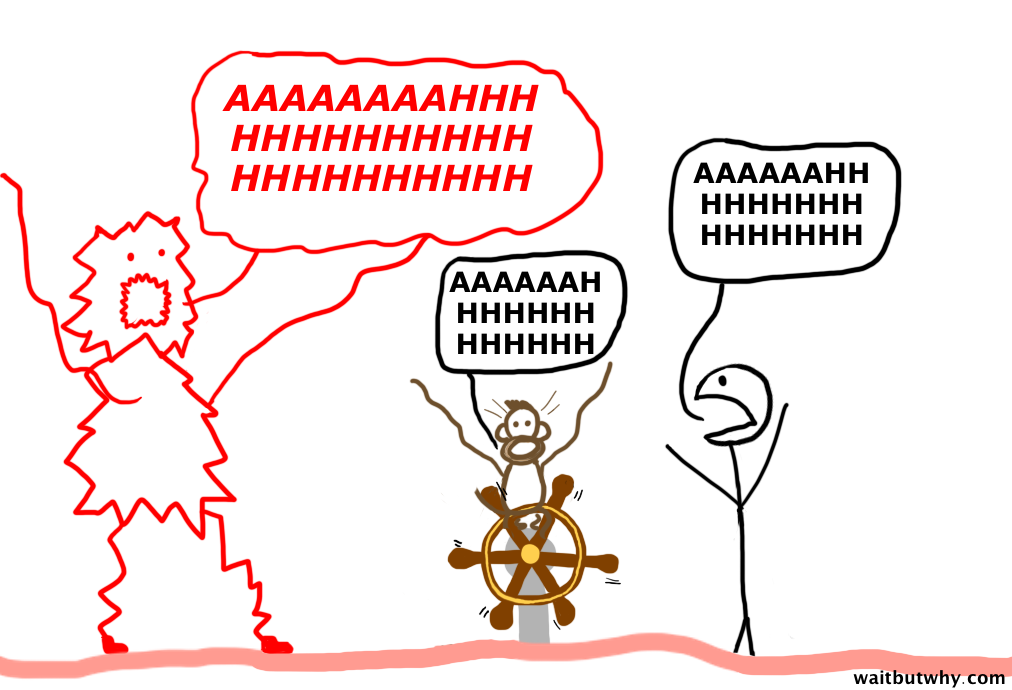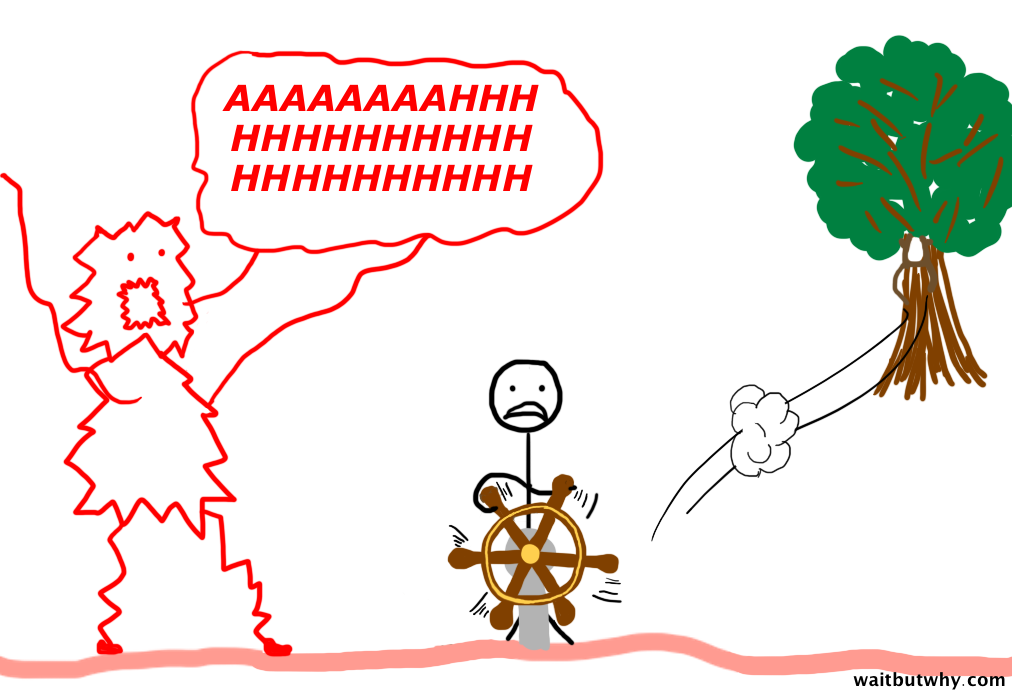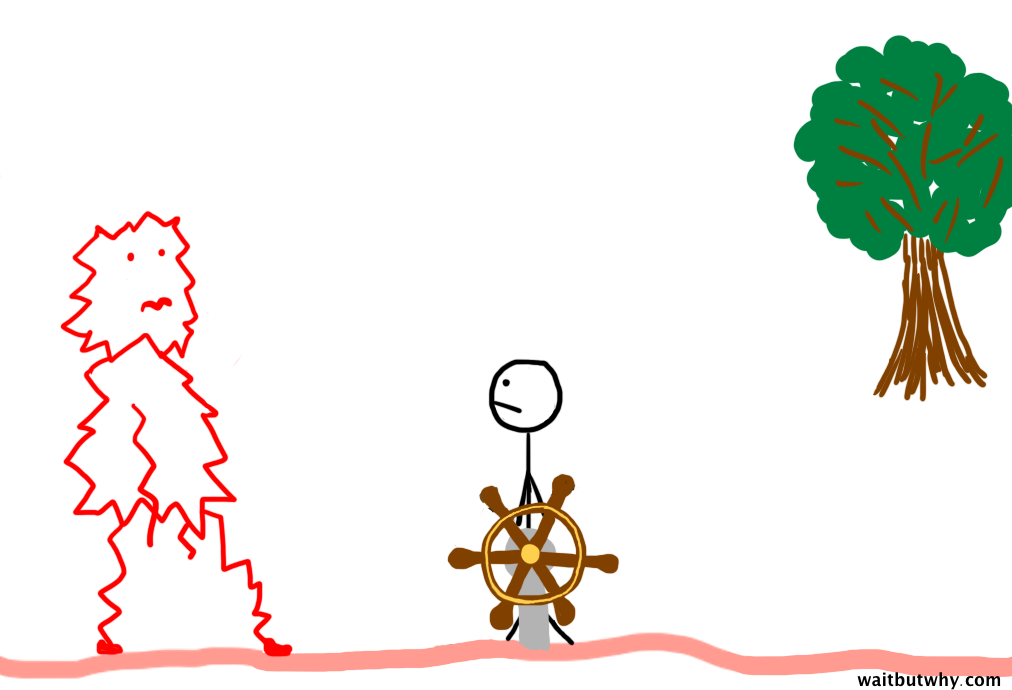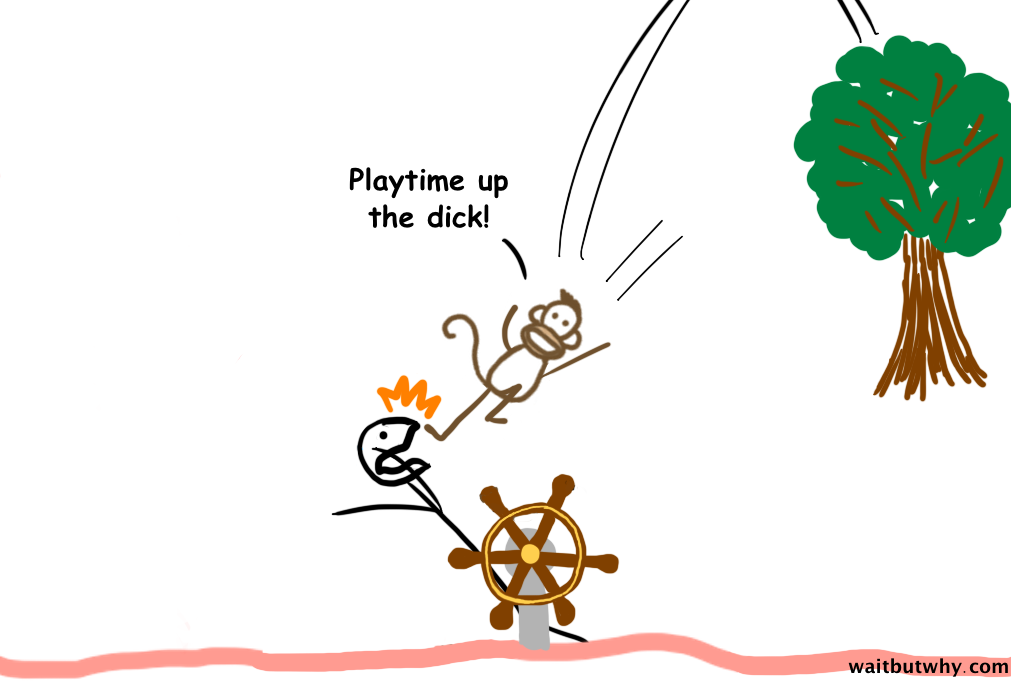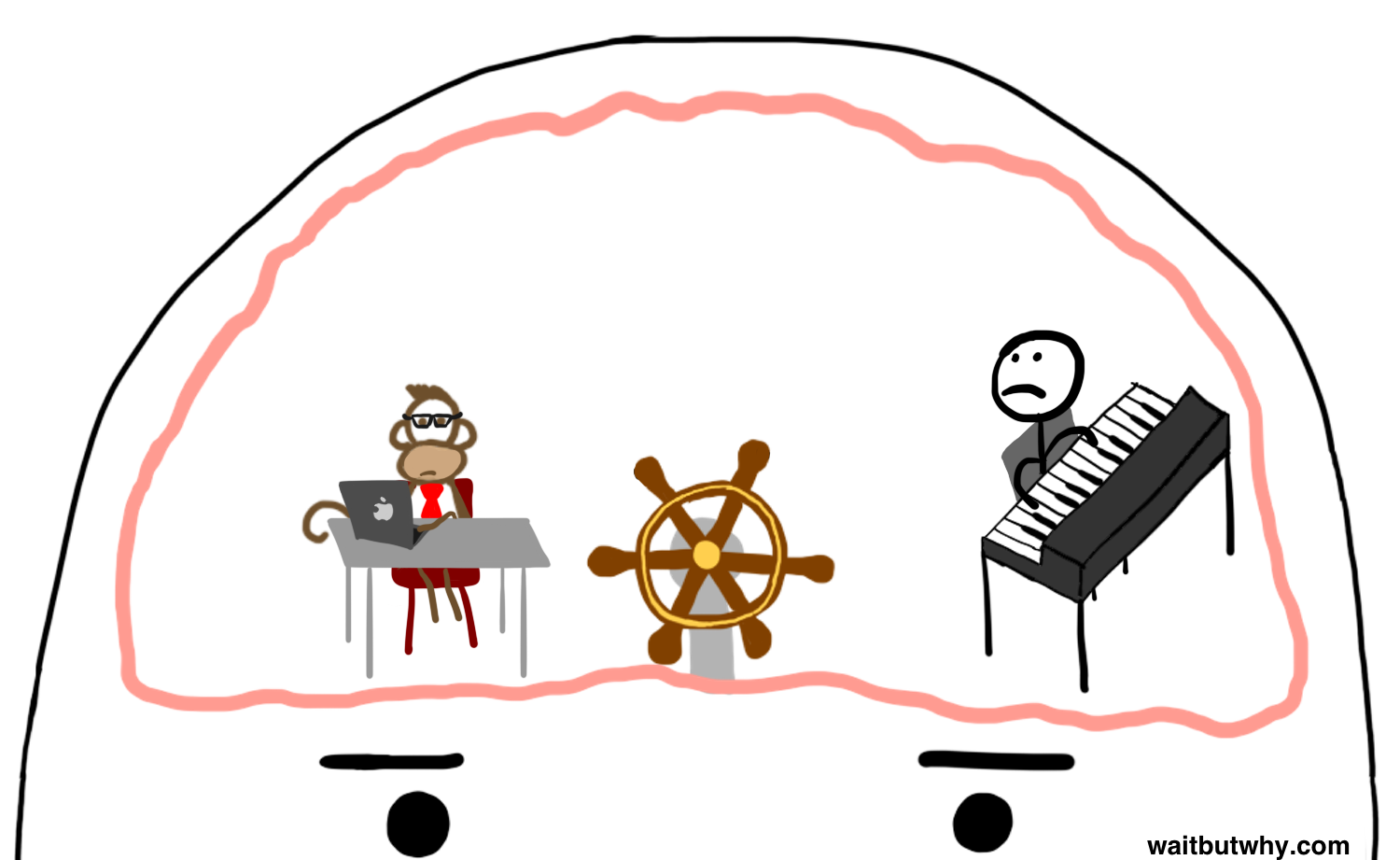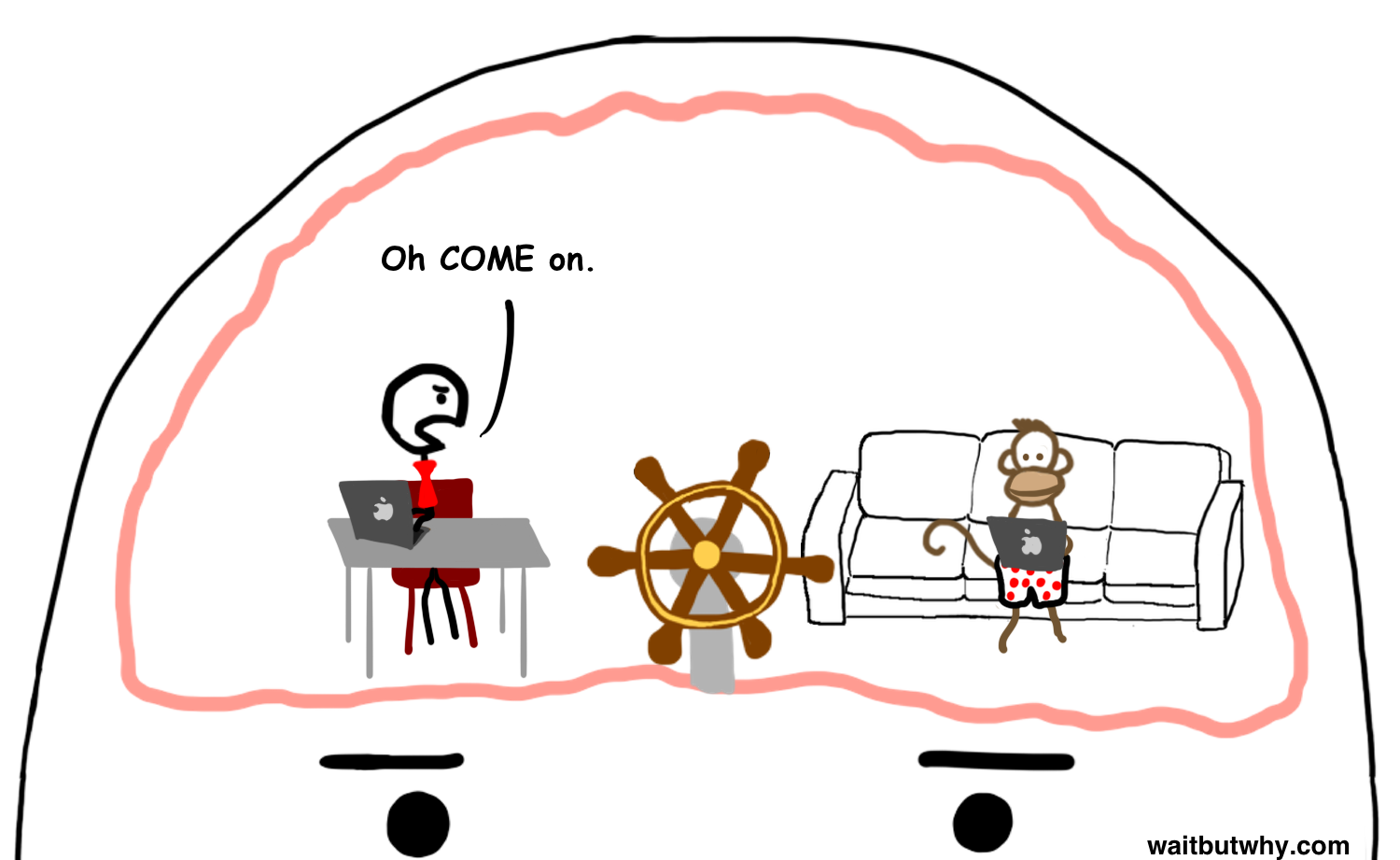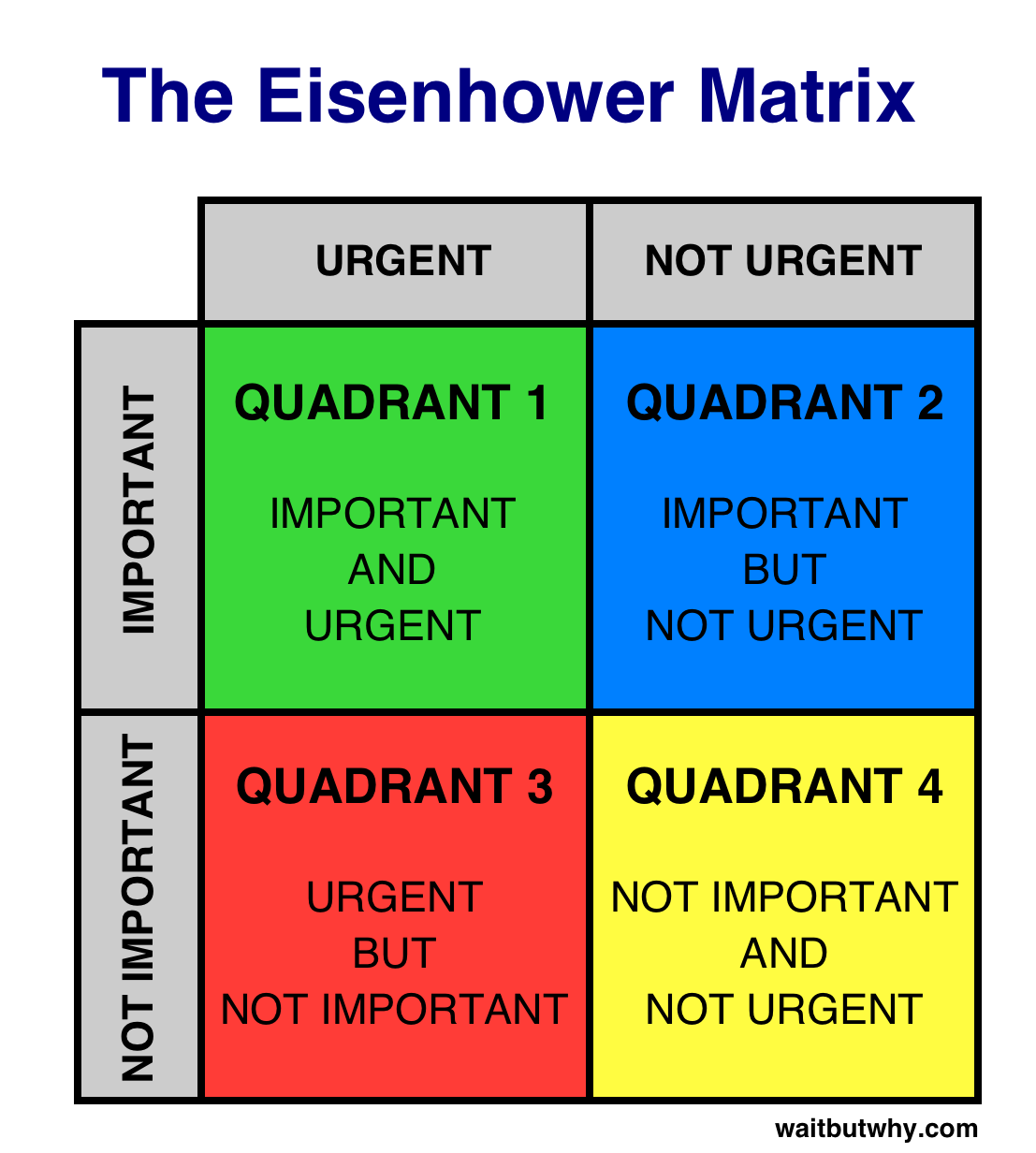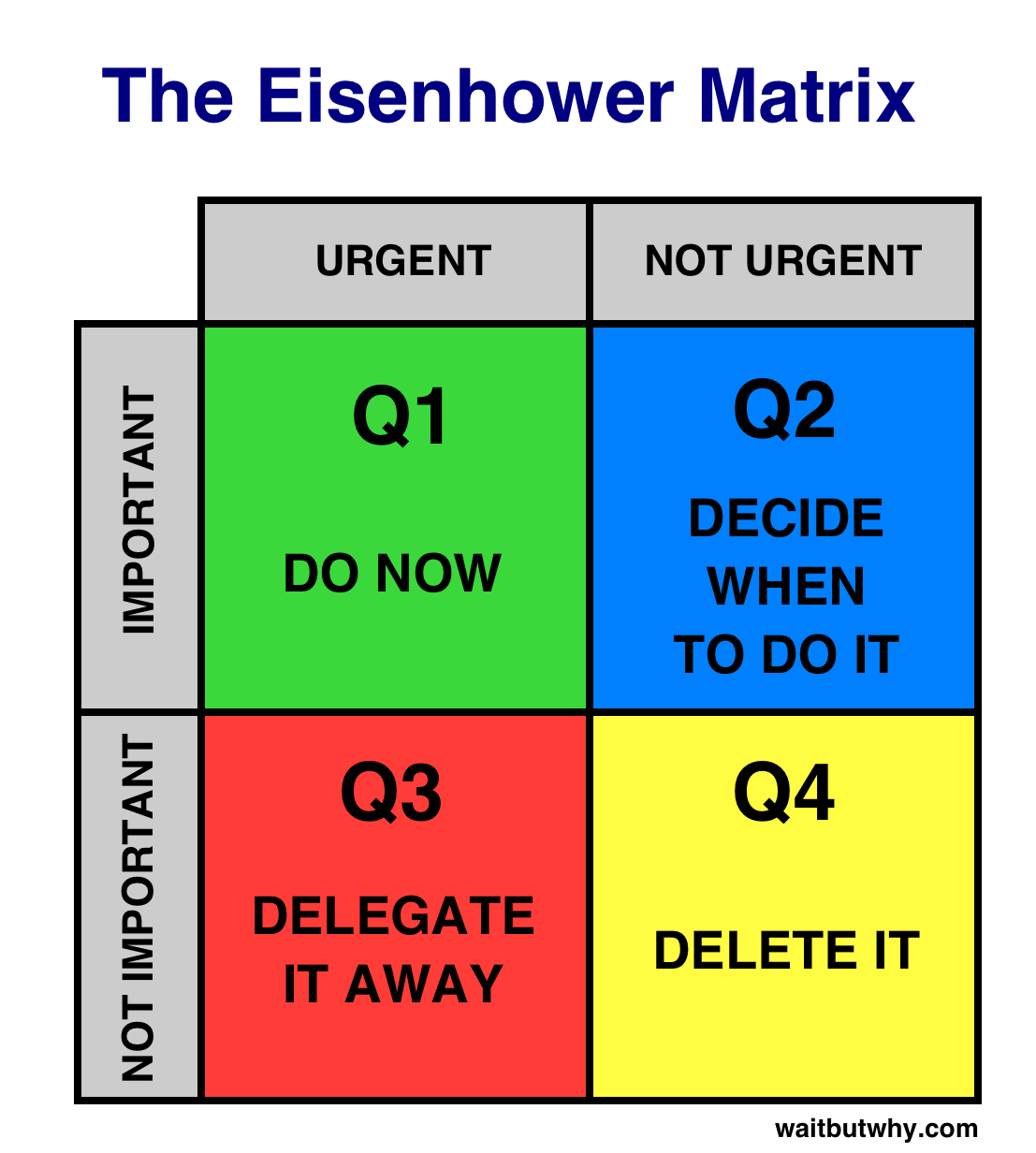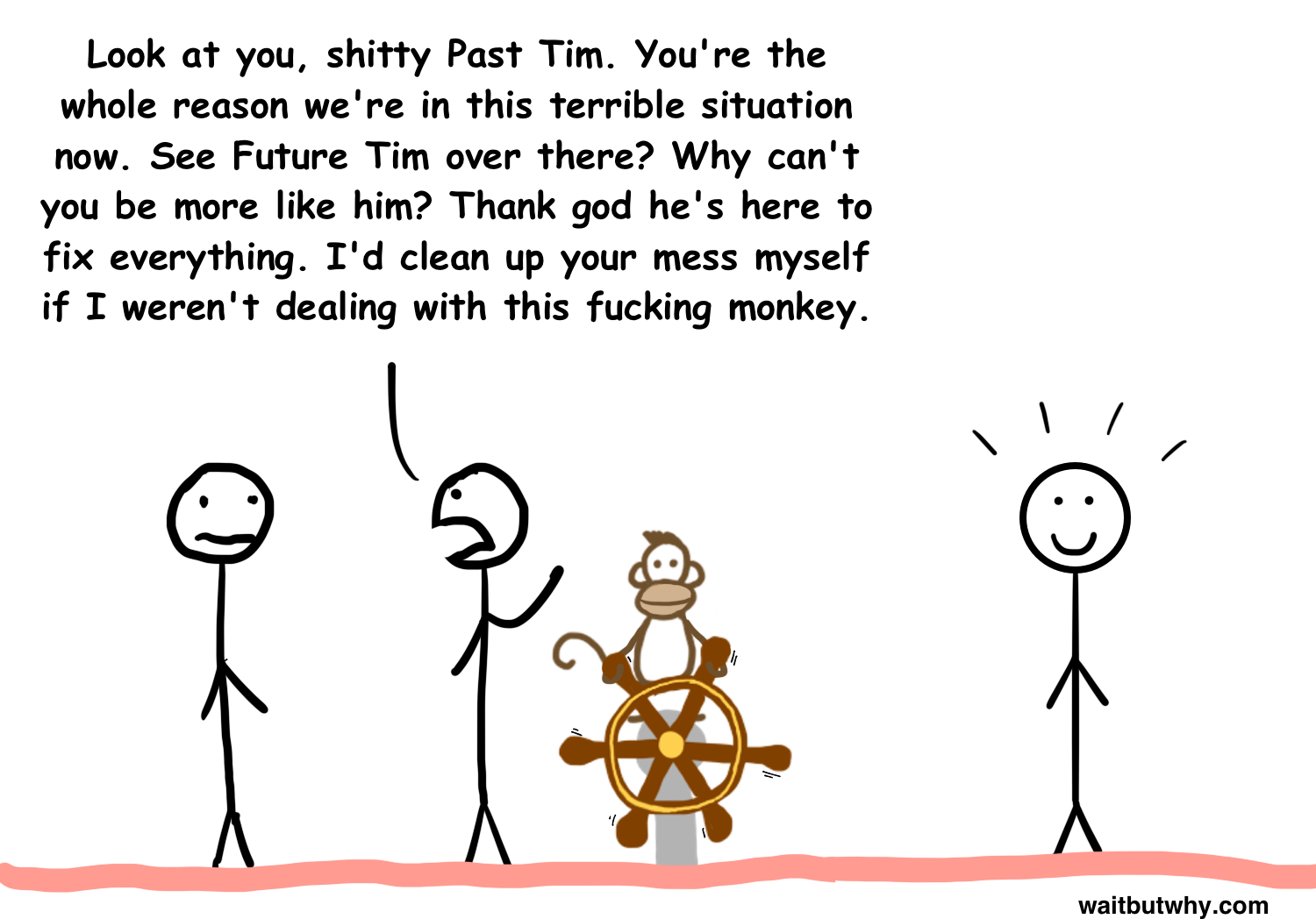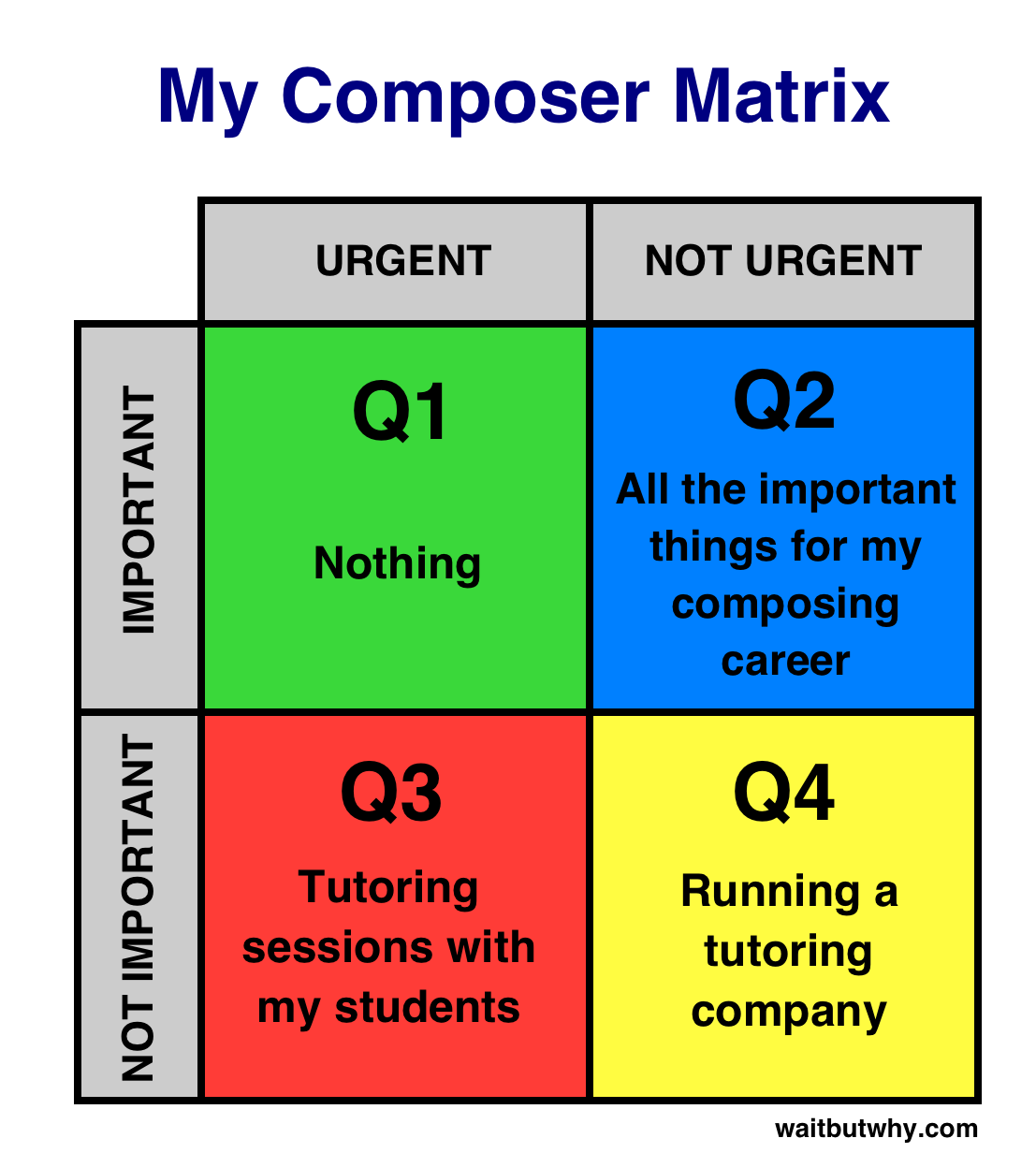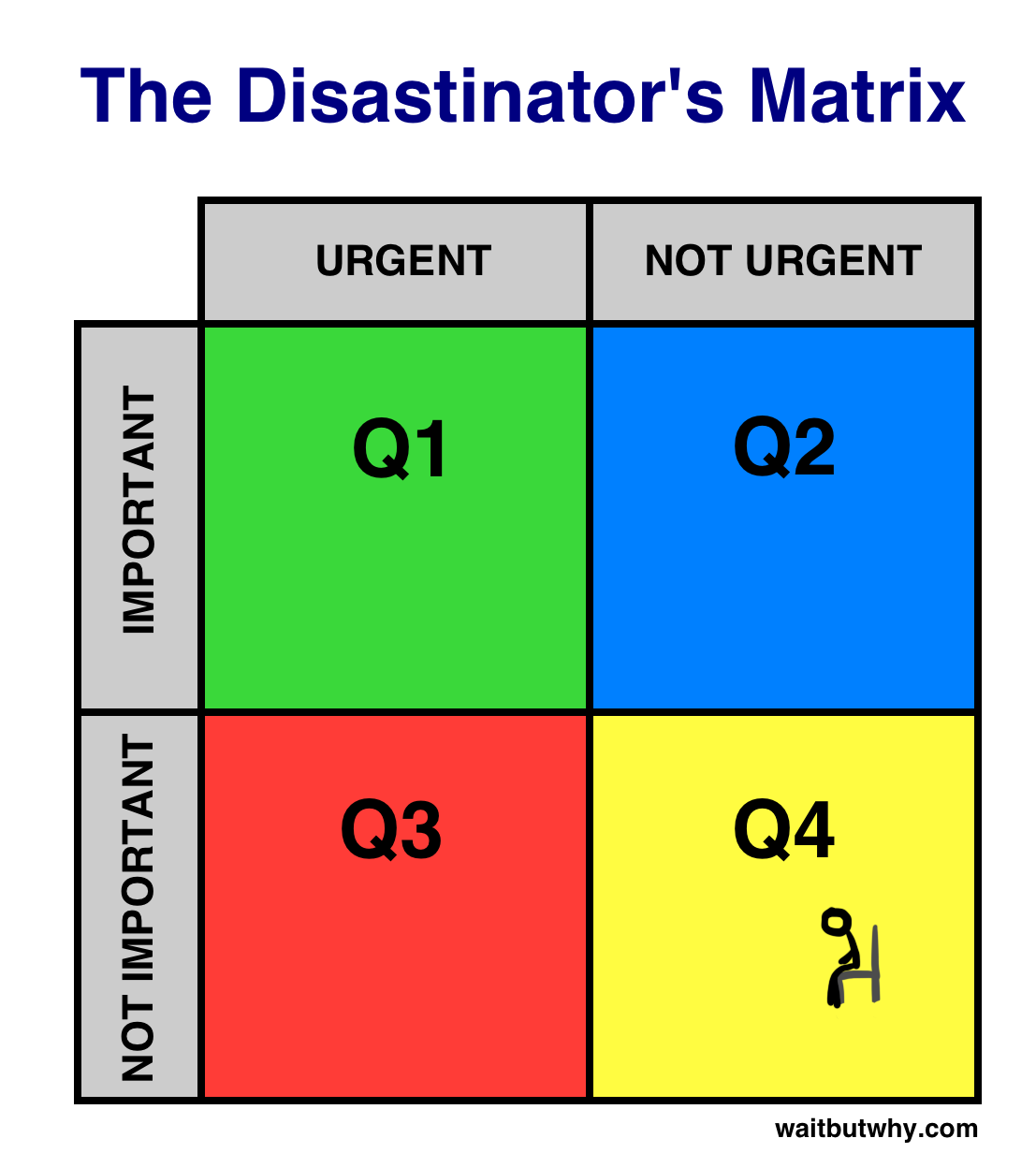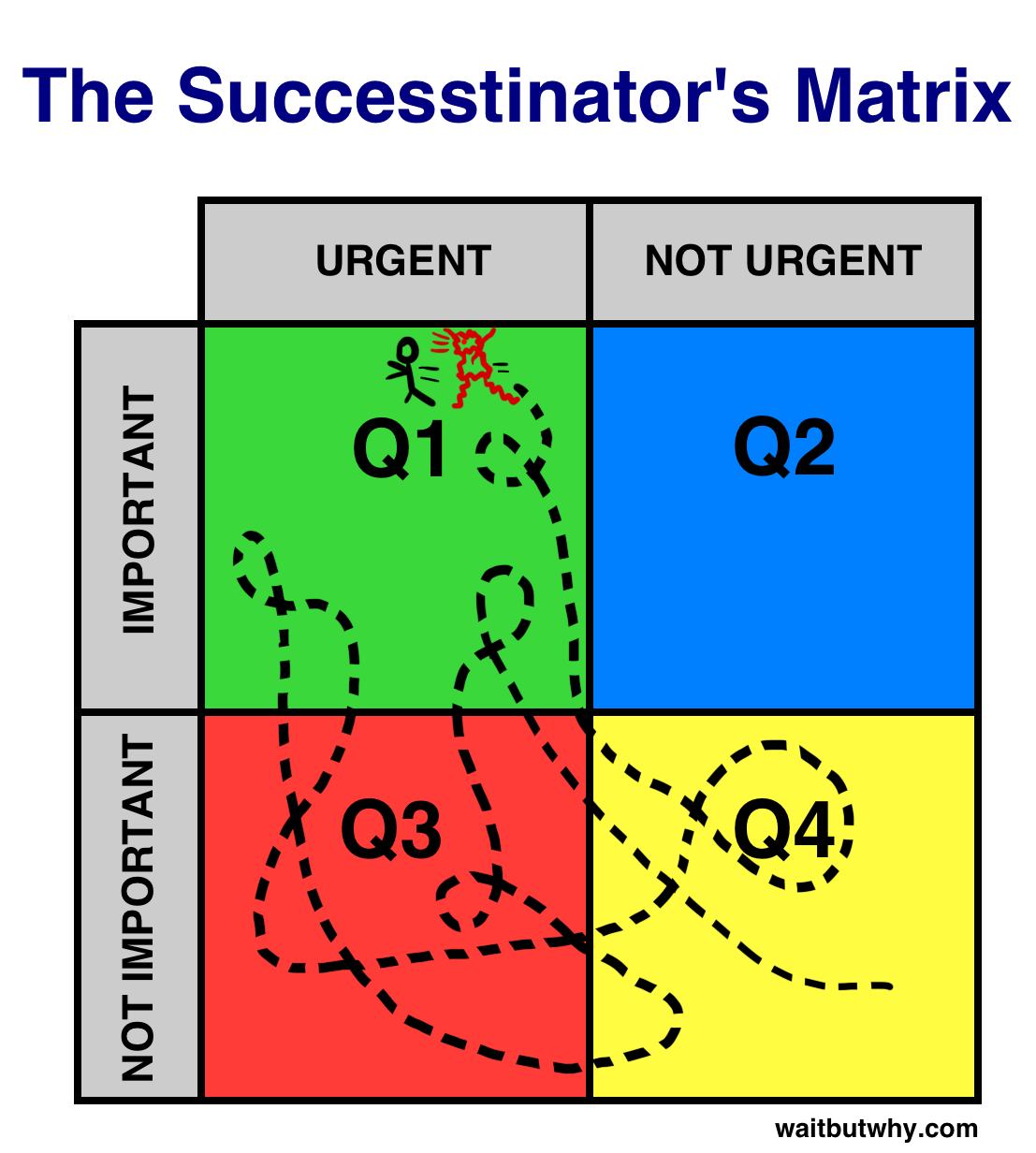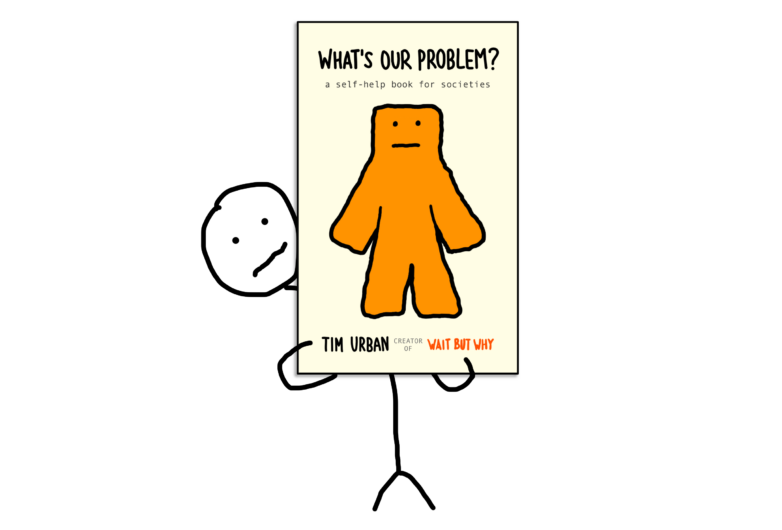Note: To best understand this post, you should first read Part 1 of Wait But Why’s previous post on procrastination.
___________
PDF: We made a fancy PDF of this post for printing and offline viewing. Buy it here. (Or see a preview.)
___________
Back in high school, if you had asked me if I was a procrastinator, I would have said yes. High school students are given all these lectures about “pacing yourself” on longer projects, and I proudly paced myself less than almost anyone I knew. I never missed a deadline, but I only did anything the night before it was due. I was a procrastinator.
Except I wasn’t. High school is full of regular deadlines and short-term projects, and even longterm projects had sub-deadlines that force pacing upon you. There were a few dire moments, but for the most part, I was just doing everything at the last minute because I knew I could probably still do well that way—so why not.
There was definitely an Instant Gratification Monkey1 in my head, but he was cute more than anything. With deadlines looming constantly, my Panic Monster2 was never fully asleep, and the monkey knew that while he could have some time at the wheel each day, he wasn’t the one in charge.
One day, high school ended, and so did my life as a somewhat normal-acting person. College is not like high school. The assignments are big, with a lot of time between deadlines, and since you’re not a child anymore, classes don’t treat you like one—no one forces you to pace anything. As a Government major, most of my classes involved a couple papers, a midterm, and a final exam over a four-month stretch, which means most of the time, there were no hard deadlines anywhere on the horizon.
Without deadlines to occupy him, my Panic Monster, who can’t think too far ahead, began to spend a lot of time in hibernation. My Rational Decision-Maker, who never realized how much he had relied on the Panic Monster, began to have difficulties carrying out his plans.
The more the Panic Monster slept, the more confidence the monkey gained. The Rational Decision-Maker, the only member of the brain who sees the world clearly, was concerned—he knew that college assignments were a lot bigger than high school assignments, and that pacing was no longer something to scoff at, but a critical thing to do. He’d put his foot down about social commitments when a deadline began to draw closer, but that wouldn’t solve the problem.
The RDM would slip further into despair, and only the times when things reached their most dire would anything change.
It didn’t matter how obvious a decision seemed to the RDM, it was becoming clear that he was totally unable to control the monkey without the Panic Monster’s help.
While college was often a disheartening experience for my RDM, it was a full renaissance for my Instant Gratification Monkey, who explored a wide range of activities in an effort to find himself. With a Yamaha electric keyboard right next to my desk, the monkey became increasingly passionate about playing the piano. It almost seemed like the times my RDM was stomping his foot the hardest about getting to work were the exact moments the monkey would feel the most spirited about putting on the headphones and becoming lost for hours in the piano.
When college ended, thrilled to be done forever with formal education, which was clearly not my thing, I burst out into the world with 1,000 ambitions to do 1,000 things. Just wait till the world saw me. I had everything imaginable to offer except knowledge, skills, and work ethic.
My RDM had done a lot of thinking about this, and he understood that the monkey had spent college trying to tell him something important—I wanted to be a composer. That was clearly the thing I was most drawn to, and finally, it would become the thing I was supposed to do each day. No more fighting the monkey—he was going to get exactly what he wanted. I had figured out life, and I moved to LA to write movie scores.
In order to pay my bills, I began tutoring kids after school on their homework or for the SAT, a side job I chose because it wouldn’t distract me from becoming the next John Williams. It was the perfect setup, I was brimming with excitement about music, and things were starting to move—when the weirdest thing happened. Just when I was sure I had found myself, the monkey began soul searching. When the RDM and I would sit down at the piano to write something—the exact activity the monkey spent college obsessed with—the monkey would throw a fit and refuse to join us. The RDM began to feel helpless, the same way he did in college.
Meanwhile, the monkey had found a new interest—he had become fixated with my side job. Tutoring was going well, referrals were increasing, and while the RDM would insist that we were already working with too many students, the monkey would accept every new job that came our way. Soon, the monkey started thinking bigger, and without running it by the rest of us, he began hiring my friends to tutor for me. The RDM would wake up eager to dive into composing, but the whole day would end up being spent on phone calls and buried in spreadsheets. The monkey had started a business.
My brain and I ended up in an unpleasant no-man’s land. The monkey refused to let us pour ourselves into our music career, and the RDM refused to embrace the monkey’s new business career. I was doing a lot of things and not giving my all to any of them.
It was around then that my best friend Andrew moved to LA. Andrew isn’t like me. He lives and breathes business, with no interest in pursuing anything in the arts, and ever since I met him when we were five, his monkey has been a tame little bitch who does what he’s told. After he moved, we started talking about maybe going into business together somehow. My RDM had refused to entertain taking business seriously until then, but the prospect of starting a company with Andrew and actually putting a full effort into it was enticing—and the monkey was clearly into it, so maybe this was the thing I was supposed to be doing all along. I decided to dive in, and building off of what I had started, we founded a new tutoring company together.
The RDM still wrestled with the decision to put a pause on the music side of things, but the company was growing quickly, being in business with Andrew was a great time—like playing a complex strategy game with your friend—and the RDM finally started to feel okay about becoming totally wrapped up in business.
Which was the monkey’s cue to become an avid blogger.
I had been casually blogging for a few years at that point, but business taking off was just what the monkey needed to kick his new writing hobby into full gear, and over the next few years, I wrote hundreds of blog posts in my off hours. I went into work every day, and I’d be engaged while I was there—but instead of doing what an entrepreneur is supposed to do outside of work and keep the wheels turning, mulling over the strategy and allowing the subconscious to drop key epiphanies on you from time to time, I’d be thinking about what to blog about next.
In 2013, when Andrew and I decided to start something new, we looked at my monkey, saw how absorbed he always was with his blog, and thought maybe that was the thing I was supposed to be doing this whole time—so we started Wait But Why. Andrew would continue to grow our company while I’d fully immerse myself in this new project, giving the monkey exactly what he so badly wanted.
___________
What was classic procrastination in college morphed into a bizarre form of insanity once I entered the real world. On a day-to-day, micro level, there was still always an element of the normal “RDM tries to do something, monkey makes it difficult” thing, but in a broader, macro sense, it was almost as if I were chasing the monkey. After he defeated me so soundly in college, I wondered if fighting against him in the first place was my mistake. He’s born from some inner, primal part of me, so wouldn’t it make sense to pay attention to his inclinations and use them as my guide?
So that’s what I tried to do—when he’d be continually drawn to something, I’d eventually take his lead and build my life around that. But the problem was, he was almost like a mirage—once I’d get to where he was, he wouldn’t be there anymore. He’d be somewhere else. This was confusing—was he there before because he actually wanted to be, or was he just there because it was where the RDM was not? Did he actually have passions of his own, or was he just some elusive evil contrarian inside of me with a mission to hold me back from ever doing anything great with my talents and energies?
Last year, I came across a little diagram that I think holds the key to these questions. It’s called the Eisenhower Matrix:
The Eisenhower Matrix places anything you could spend your time doing on two spectrums: one going from the most urgent possible task to the least urgent, the other going from critically important to totally inconsequential—and using these as axes, divides your world into four quadrants.
The matrix was popularized in Stephen Covey’s famous book, The Seven Habits of Highly Effective People and is named after President Dwight Eisenhower. Eisenhower was well-known for being tremendously productive, which Covey credits to his “first things first” attitude on how to spend your time. And to Eisenhower, the “first things” were always the important ones. He believed you should spend nearly all of your time in Quadrants 1 and 2, and he accomplished this with a simple D-word for each quadrant:
And that’s fantastic for Dwight fucking Eisenhower. But you know what Dwight clearly didn’t have in his bald head? An all-powerful Instant Gratification Monkey. If he had, he’d know that a procrastinator’s matrix looks like this:
If you ever want any information on Quadrant 4—directions, places to eat, etc.—just ask a procrastinator. They live there. For a non-procrastinator, Q4 is a happy place to spend time. After a productive day working on important tasks, it feels great to kick back in Q4—and under those circumstances, there’s a name for Q4: The Happy Playground. But procrastinators don’t tend to hang out in Q4 after an efficient day of high-level work—they’re there far more often than that, against their will, because the monkey has dragged them there, all while the Rational Decision-Maker is begging them to leave. And they have a different name for Q4: The Dark Playground.
As for Quadrants 1 and 3—the urgent quadrants—most procrastinators will end up there from time to time, usually in a full sweat, with the Panic Monster next to their face screaming. Q1 and Q3 keep the procrastinator off the streets.
And then there’s Quadrant 2. To a procrastinator, Quadrant 2 is a strange and foreign land, far, far away. Kind of like Atlantis, or Narnia. He knows it’s an important place, and he’s tried many times to go there, but there’s a big problem—the monkey is repulsed by it, and the Panic Monster isn’t concerned with it. And that’s the deadly combo that defeats the procrastinator every time.
The reason this is disastrous is that the road to the procrastinator’s dreams—the road to expanding his horizons, exploring his true potential, and achieving work he’s truly proud of—runs directly through Quadrant 2. Q1 and Q3 may be where people survive, but Q2 is where people thrive, grow, and blossom.
But if you’re a procrastinator, you’re in luck. You have an ace up your sleeve—someone daring and fearless, with bountiful energy and dynamic talent, and someone who can defeat the monkey like stepping on an ant: Future You.
Future You is a procrastinator’s most important ally—someone who’s always there and always has your back, no matter what. I know all about this firsthand. Future Tim is an amazing guy.
When my alarm goes off and I don’t want to wake up, I just press the snooze button, which doles out the job of getting out of bed to Future Tim instead. My to-do list has two parts—a short, easy one for me, and a long one, full of all the things I can’t imagine ever doing, because they’re so icky-seeming. Future Tim always handles that one, without a complaint. Future Tim also has no problem with even the vilest of social obligations. I was recently invited to attend a feedback-giving session for a three-hour-long play written by someone I barely know—I certainly had no intention of ever doing that, but I would also have felt guilty just saying no, so I explained that I have a busy couple months, but that I’d be more than happy to join when it happens again this summer, a time when it’ll be Future Tim’s problem, not mine.
Future Tim also has a discipline and balance to his lifestyle I could only ever dream of. I’ve never been much of an exerciser—but Future Tim belongs to a gym and does all the jogging for both of us, and I love how into cooking healthy meals Future Tim is, because I personally don’t have the time. Future Tim is the kind of guy we all want to be like—I suggest getting to know him yourself, which you can do by buying his books, since he’s a prolific author.
But the most important role Future Tim plays in my life brings us back to the Eisenhower Matrix. In a convenient stroke of fate, Future Tim happens to spend almost all of his time in the one place I can never seem to get to myself: the all-important Quadrant 2. Future Tim is Quadrant 2’s warden, and when I make a list of important to-do items and notice that most of them seem to land in Q2, I don’t have to despair, because I know Future Tim is on top of them. Which is good, considering how dire a situation Past Tim, that useless fuck, has often left me in:
But for all of Future Tim’s virtues, he has one fatal flaw that kind of ruins everything: he doesn’t exist.
It turns out that Future You is as much of a mirage as the monkey’s passion for a hobby. I banked on Future Tim’s real-world existence for my most important plans, but every time I’d finally arrive at a time when I thought I would find Future Tim, he was nowhere to be found—the only person there would be stupid Present Tim. That’s the thing that really sucks about Future You—whenever time finally gets to him, he’s not Future You anymore, he’s Present You, and Present You can’t do the tasks you assigned to Future You because those tasks can only be done by someone without a monkey. You assigned them to Future You in the first place because he doesn’t have a monkey—that was the whole point. So you do what you always do—you re-delegate them to Future You, hoping that next time time catches up with Future You, he actually exists.
This is what left me unable, for years, to give life my full effort. The important work to be done usually lives in Q2, a place I had a hard time going to, so I’d direct the extra energy to a passionate hobby instead. The monkey would get super into these hobbies, because hobbies are, by definition, in Q4—a place the monkey loves to be.
So here’s what went on when I was supposed to be pursuing a composing career:
And when I decided to “follow the monkey’s lead” and take on business, I was missing the key point: “taking on” business meant making business the thing I was supposed to do, which turned it from a not important task into an important one—moving “business” from Q4, the monkey’s favorite place, to Q2, his least favorite place.
The fact that I expected the monkey to remain obsessed with business after the switch to Q2 shows how little I understood the monkey. The monkey’s passion never was music, or business, or blogging—the monkey’s passion was always Q4.
And the thing the monkey really likes about Q4 isn’t anything about Q4 in particular—it’s that Quadrant 4 isn’t Quadrant 1 or 2. The monkey, whose core drive is to do whatever’s easiest, can’t stand the “important” quadrants, because the important quadrants are where the pressure’s on—it’s where there’s something to prove, where your actions have consequences, where the stakes are high, and where you’re shooting for the stars, which means you might fail to reach them. No fucking thanks, says the monkey. Writing 300 blog posts while I was supposed to be dreaming up brilliant business growth strategies wasn’t “easy” in the sense that I didn’t have to work hard to write them—it was easy in that there was nothing at stake. Stakes are really what’s hard for a human.
___________
When I started writing posts for Wait But Why, I knew I wanted to write about procrastination. I needed to try to articulate the madness that went on in my head. After assigning that daunting mission to Future Tim for a while, I finally bit the bullet and did it.
The reaction was overwhelming. In addition to the over 1,300 comments on the two posts, here’s the breakdown of emails I’ve received from readers:
There have been thousands of emails. Apparently this whole thing isn’t just me.
And the emails aren’t quick, “Hey I liked the procrastination posts bye” notes—they’re thorough. And heartfelt. A good number of them mention that the posts made them cry. And they’re not crying because they were moved by my shitty stick drawings—they’re crying because they were reading about one of the biggest problems in their lives.
The profiles of those who have emailed range wildly, covering all ages, all kinds of professions, and hailing from almost every country in the world. I’ve heard from a 13-year-old in Pakistan, a middle-aged professor in Argentina, an 80-year-old retired nurse in Mississippi; a German graphic designer, an Australian author, a Ghanaian filmmaker, a Korean entrepreneur. And the PhD students—the hordes of PhD students—doing the ultimate Q2 task.
In one way, these people all have the same exact problem, and the same problem I have—an Instant Gratification Monkey they can’t control. But I’ve noticed, after reading every one of their stories, that the extent to which this problem is ruining their lives varies drastically, depending on a few key facts about their particular circumstances. This distinction places the readers who have emailed into three categories:
1) The Disastinators
Of all procrastinators out there, the Disastinators are in the worst shape. A Disastinator is permanently camped out in Quadrant 4, and procrastination is completely destroying their life. A procrastinator usually becomes a Disastinator for one of two reasons:
A) Their monkey has stopped being scared of the Panic Monster and has become all-powerful
B) They’re a normal procrastinator but they’re in a life situation with no external deadlines or pressure
Situation A is super-dark, and as I’ve learned from reader emails, not that uncommon. These people have lost the ability to do almost anything that matters to them and are either in a downward spiral or have given up entirely.
In Situation B, the Disastinator isn’t a worse procrastinator than any other, it’s just that their circumstances are a catastrophic match for their personality. The nature of their life and work gives the Panic Monster no reason to wake up at all, and unfortunately, the monkey isn’t scared of the Self-Loathing Monster.
The outcome is that the Disastinator gets nothing done, ever. Many of the PhD candidates who emailed me fall into this category.
2) The Impostinators
We haven’t talked much about Quadrant 3, but it might be the most dangerous quadrant of all, and it’s where the Impostinator reigns king. The Impostinator’s life looks like this:
The Impostinator seems productive, but she’s really an imposter—a procrastinator wearing a productive person mask. By spending all of her work time in Q3, she seems busy—she is busy—but she never seems to make much progress on her real goals.
Impostinators have clever monkeys, and Q3 is the monkey’s most clever trick. The monkey knows that the RDM, who can be gullible, can be appeased if he spends ample time out of the Q4 Dark Playground. So the Impostinator’s monkey creates a battle that goes back and forth between Q4 and Q3, and that works because Q3 feels productive to the Impostinator. It relies on one major delusion of the Impostinator—that busy = productive.
So an Impostinator will spend the whole day answering emails, running errands, making phone calls, organizing lists and schedules, participating in meetings, etc. and if she’s judging herself by time spent out of the Dark Playground, she’s a smashing success. But at the end of the day, the satisfaction she feels has a hint of emptiness to it, and the Happy Playground is never quite fully happy. She may have deluded herself into thinking she’s living a productive life, but in her subconscious, she knows she’s not doing what she’s supposed to be doing. Her feelings of accomplishment come along with an undercurrent of despair.
In reality, she’s living in a grand, overarching procrastination, brilliantly crafted by her monkey. Rather than try to win the tug-of-war between doing what matters—the stuff up in Q2—and the Dark Playground, the Impostinator’s monkey tricks the RDM into fighting on the wrong battlefield, and he lets the RDM “beat” him on this battlefield, which leads her to believe she’s doing a good job.
The other difficulty the Impostinator faces is that sometimes Q3 disguises itself as Q1. A busy Impostinator often believes that the urgent work she’s consumed with is important, but the problem with that is what Eisenhower himself said best:
What is important is seldom urgent, and what is urgent is seldom important.
In other words, Quadrant 1 often does not exist. This isn’t always the case, but it’s especially likely to be true for people who have yet to get their career rolling, because usually when your truly important work is also urgent, it means you have something good going on. This creates a catch-22, where the people who most need urgency in order to do things—procrastinators early in their career—are often those with a totally vacant Quadrant 1.
The more time goes on, the more I think that being super busy tends to mean having a packed Q3 (usually mixed in with too much Q4 time). I know that when I’m in one of those zones where I’m telling everyone how busy I am and how little time I have for them, it’s almost always because I’m overloaded with Q3 bullshit. People who are really on top of their life—really in control—tend to have plenty of space in their schedules. But society smiles upon busy people, the phrase “I think you have too much time on your hands” is an insult, and that leaves Impostinators looking—and often feeling—like they’re doing it right. And while the Impostinator will always feel superior to the Disastinator, the truth is that in terms of real productivity on things that matter, they’re equal.
The major lesson here is to beware of Quadrant 3. Q3 grabs you by the collar and thrusts you onto a treadmill of reacting to things. It’s not a place of self control. And if you’re not careful, Q3 will suck your life away. I know, because I’ve spent a lot of my life as an Impostinator.
Of the many Impostinators who emailed me, the most common professions were artists of some kind or entrepreneurs. In both of those situations, you’re the boss of your own life, and the important work to do—improving your skills, deepening your network, executing a creative vision—is rarely urgent.
3) The Successtinators
After spending most of my life feeling unable to maximize myself, since starting Wait But Why a year and a half ago, I’ve written over 250,000 words—the equivalent of 1,000 book pages—and what I’m doing really matters to me. For the first time, the satisfaction of accomplishment doesn’t come along with a twinge of guilt or emptiness or despair. I’ve done it! I’m a doer.
Not quite.
The reality is, I haven’t overcome my monkey problems one ounce more than the Impostinators and Disastinaters who emailed me—the big difference is, I’ve gotten myself into a situation where I have a big, fat Quadrant 1 in my life. Not a fake Q1 that’s really Q3 in disguise—but a genuine Q1, and it’s packed. The intimate relationship a blog has with real, living people—and the pressure that generates—turns a blogger’s important work into urgent work, as soon as there are enough readers that the Panic Monster takes interest in things.
For a procrastinator, this is the opposite of the PhD-type situation, which I described as a catastrophic match for a procrastinator. Writing regularly with an immediate audience is an example of a terrific match for a procrastinator’s personality, because it puts his Panic Monster in the optimal location—it aligns the Panic Monster with his most important endeavor.
Of course, my monkey is still wreaking havoc over my whole life in any way he can—I pulled a lifespan-reducing all-nighter to finish this post. But there’s a key distinction between what he’s doing now and what he was doing during my previous projects. With those other projects, he spent his Q4 time pursuing real, ambitious projects—and he was allowed to do that because the RDM wasn’t entirely sure what he wanted, and he would question whether the monkey was actually on to something with his distractions. But at least so far, working on Wait But Why is hitting the nail on the head for the RDM, because he’s actually spending a lot of time above the important line, so he has a conviction about the undertaking he didn’t previously. Because of this, he’ll let the monkey tap dance around Q4 and Q3, mainly because he has no power not to, but he won’t allow the monkey to take on anything serious with his time.
I have not conquered procrastination, but for the time being, at least, I’m in the least bad type of procrastinator situation—I’m a Successtinator.
A Successtinator has found a solution-ish to his problems, but it’s not pretty, often not healthy, and usually not sustainable. It’s a clever duct-taping of a troubled machine to hold it over temporarily.
I received a lot of emails from Successtinators, and the patterns were consistent and resonate with my own current situation. A Successtinator can be happy with his life, but isn’t usually that happy in his life. And that’s because being a Successtinator does not make you a success. Someone who does something well professionally at the expense of balance, relationships, and health is not a success. Real success means having both professional life and lifestyle working well and in harmony—and Successtinators are too stressed, too unavailable, and are often completely deprived of Happy Playground time, which is a critical component of a happy life. A Successtinator is also usually limited in his professional possibilities—great work can be done in Q1, but it’s often more on the maintaining side of things. Q2 is still where most of the professional growth and out-of-the-box thinking takes place, and like all procrastinators, Successtinators rarely set foot in Q2.
___________
There are bigger problems in the world than procrastination. Things like poverty, disease, mental illness, and drug addiction all make procrastination seem glaringly like a problem of the privileged—something to suffer over for those whose lives have no real suffering.
But if a skeptic spent a few hours reading through the mound of procrastination-related emails I’ve received, I think they’d agree that this is a dire problem in many, many lives. And it doesn’t just harm the procrastinator—it hurts the people close to the procrastinator, spreading the effect.
It’s also the world’s loss. For every Steve Jobs or John Lennon or J.K. Rowling or anyone else whose talents have enhanced our lives, there are thousands of people with just as much potential who never achieve much for the world because they waste away their time in the wrong quadrants.
One way to look at this is that each human life has a certain number of “time points,” and it’s up to you how you “spend” them. Consider the difference between someone who spends 30 hours a week in Q2 and someone else who only manages two hours of Q2 time a week. Since Q2 is, for many, where real advancement happens, over the course of their lives, the 30 hour person will accomplish 15 times as much in her life as the two hour person. And in reality, the multiplier is probably even larger than 15, since progress builds upon progress and the rate can accelerate (i.e. Steve Jobs wouldn’t have accomplished 1/15th of what he accomplished if he had put in 1/15th the productive hours—he probably would have accomplished none of it.) The distinction between an ordinary person and an extraordinary person might simply come down to the differences in how they allot their time points.
Clearing away delusion
If we want to improve our time point spending, the first step is learning to see the world through a crystal clear Eisenhower Matrix—which means shaking off all delusion. We need to develop well-thought-out definitions of urgent and important, which will be different for everyone and requires a deep dig into the highly personal question, “What matters most to me?”
Brett McKay defines “important tasks” as things that contribute to our long-term mission, values, and goals. This is broad and straightforward and a good core sentence to come back to when assessing importance down the road.
The thought process about what is and isn’t urgent should revolve around the self-discussion of what’s most important. Ideally, urgent would not mean, “The thing grabbing me hardest by the collar”—it would be defined by what, of the important tasks on your list, would benefit most from happening sooner rather than later. Using this definition, spending time with your kids would certainly qualify as urgent, while under the typical deadline-related definition of urgent, it would qualify as “not urgent.” In other words, the order of your priorities is much better off being set by your RDM than your Panic Monster. Wisdom resides in the RDM, and when the mindless Panic Monster calls the shots on what’s urgent and what’s not, you take the RDM’s wisdom out of the game.
You may also want to gather some hard data on how you’re currently spending your time points, by logging your hours for the next week and seeing just how many of them fall into each of the four quadrants (you’ll probably be unpleasantly surprised by the results).
Becoming the boss of your brain
Once you feel clear on your Eisenhower Matrix and where its various boundaries lie, you’ll need to do the hard part and gain control over how you spend your time points within it. Which, for a procrastinator, is life’s greatest challenge.
The rewards of gaining control are obvious. It’s incredible how much a person can get done—while also maintaining a balanced lifestyle—if they’re in control of their time point spending. And those not in control will lose most of their time points to Q3 and Q4 and feel like they don’t have time for either their work or their lifestyle, all while accomplishing very little. Time point allotment is everything.
A procrastinator in desperate straits can take a half step in the right direction through the brute force method of rearranging his life in a way that makes him a Successtinator. That’s where I am now, and it’s a hell of a lot better than where I was before.
But that’s like hiring a bodyguard instead of learning how to fight. The real goal of a procrastinator must be to figure out how to become the boss of his brain. A procrastinator’s reality is that his inner self—his Rational Decision-Maker—is the grandmaster of his life in theory, but in practice, only a spectator. The procrastinator’s RDM goes, helplessly, where the waves take him, shuffled from activity to activity by the primal forces of the monkey and the Panic Monster. Until a procrastinator’s RDM can walk, on his own, from Q4 to Q2, whenever he wants to, he’s not fixed.
___________
If you Google “how to stop procrastinating,” you’ll find about 1,000 articles, all offering terrific advice on how to do it. The problem is that the articles are always written for sane people, and procrastinators aren’t sane people. Being insane, procrastinators are always under the delusion that they’re sane, so they read an advice article and think they’ll be able to apply it to their life. But then it doesn’t work out that way.
Before a procrastinator can act on good advice, he needs to have control. A race car driver can get all the coaching in the world, but if, when the race starts, someone else is controlling the steering wheel and the pedals, all the coaching is useless.
That’s why the only way a procrastinator can take the wheel in his hands is if his self-fulfilling prophecy—his storyline— says that he can. And storylines only change with real-world action. Quite the chicken and egg issue.
At its deepest level, it comes down to a battle of confidence. The RDM and monkey each have their own idea of how to spend your time points, and whichever of them is more confident—whoever has a stronger belief that they’re the alpha dog in the relationship—ends up prevailing. The difference between a procrastinator and a non-procrastinator is simply that the procrastinator’s monkey and RDM both believe that the monkey is the alpha dog, and the non-procrastinator’s pair both believe that the RDM is the boss.
But as firmly entrenched as these confidence levels may feel, the monkey and the RDM share a single pool of confidence with a fixed sum—when one’s confidence goes up, the other’s goes down—and the balance can begin to be tipped by the smallest changes, taking your storyline with it.
Figuring out the starting point of this chicken and egg paradox is each procrastinator’s personal quest. But a universal starting point is to try to remain aware as much as possible. Aware of what’s important, aware of what’s urgent, and most importantly—aware of the monkey. The monkey is not your friend, and he never will be. But he’s also part of your head and impossible to get rid of, so get in the habit of noticing him. When you wake up in the morning, he’ll be there. When you sit down to work, he’ll be there. Whenever you most badly need all the guts and grit you can muster, he’ll be there to take your guts and grit away.
But he thrives off of unconsciousness. Simply by noticing him and saying to yourself, “Yup, there’s the monkey, right on cue,” you can start to tip the balance out of its default state. Then maybe one day, you’ll find yourself nonchalantly shoving the monkey off of the wheel with the simplest, “No monkey, not now.” And your life will be forever changed.
___________
I love the emails I’ve received about procrastination, and I hope they continue. But I always wish the people who have emailed me could hear each other’s stories. I encourage anyone who feels like sharing their story to do so in the comments.
If this post was up your alley, also check out:
Wait But Why’s two earlier posts on procrastination – Part 1, Part 2.
Life is just today over and over and over again – Life is a Picture, But You Live in a Pixel
A one-image reminder to spend your time points wisely – Your Life in Weeks
A deeper look at what goes on in our brains and why awareness is so critical – A Religion for the Non-Religious
A look at a different animal struggle going on in a different part of the brain – Taming the Mammoth: Why You Should Stop Caring What Other People Think
And while they’re ruining your life, you might as well cuddle with them:

_______
If you like Wait But Why, sign up for our email list and we’ll send you new posts when they come out.
To support Wait But Why, visit our Patreon page.
For the uninitiated, the Instant Gratification Monkey is the part of your brain that makes you procrastinate—he’s a primal part of you who lives to maximize the ease of the present moment. Read more about him here.↩
For the uninitiated, the Panic Monster is the part of your brain that wakes up and has a freakout when a deadline draws too close. He’s the only thing the monkey is terrified of and the only reason a procrastinator ever manages to get anything done. Read more about him here.↩
